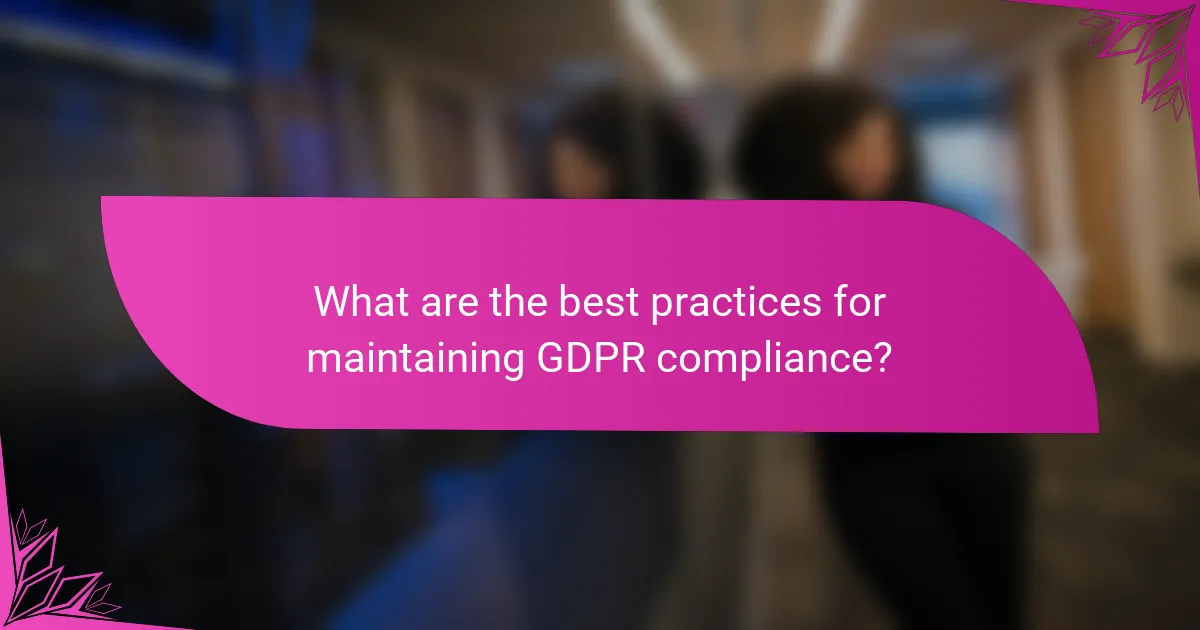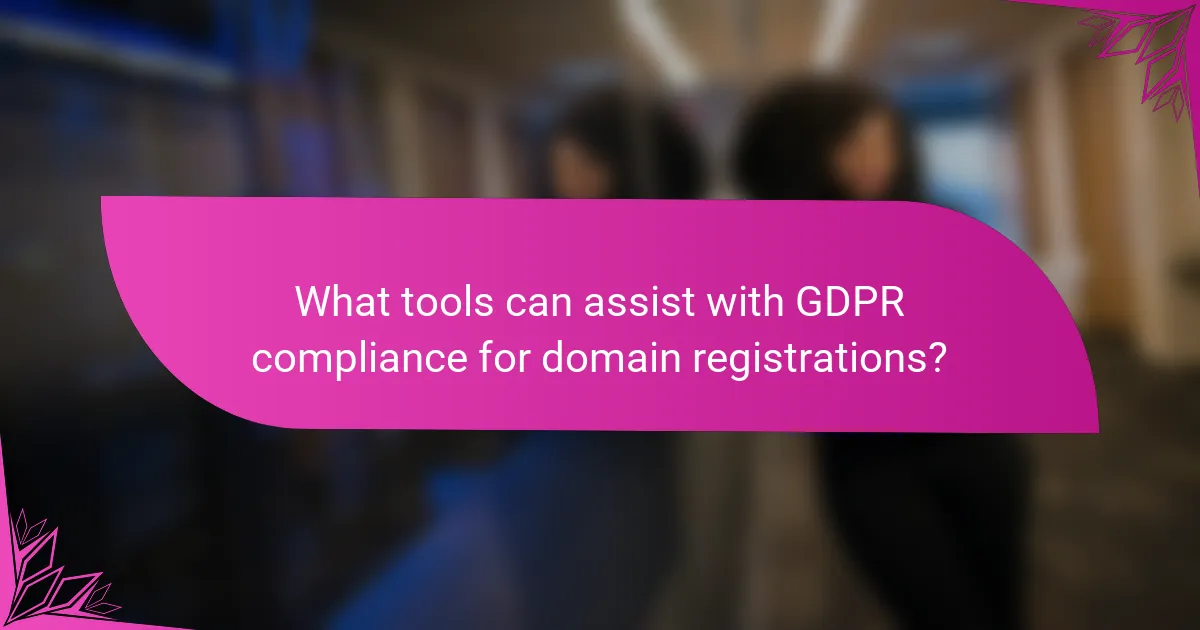Navigating GDPR compliance for domain registrations in Portugal is crucial for organizations to protect personal data and avoid severe penalties. Key steps include understanding GDPR principles, registering with the Portuguese Data Protection Authority, and implementing robust data protection measures. Choosing a GDPR-compliant domain registrar is essential, as it ensures transparency in data handling and adherence to privacy regulations.

What are the key steps for GDPR compliance in Portugal?
To achieve GDPR compliance for domain registrations in Portugal, organizations must follow several essential steps. These include understanding GDPR principles, registering with the Portuguese Data Protection Authority, implementing data protection measures, conducting Data Protection Impact Assessments, and ensuring transparency in data processing.
Understand GDPR principles
GDPR principles form the foundation of data protection regulations in Portugal. Key principles include lawfulness, fairness, and transparency, as well as purpose limitation, data minimization, accuracy, storage limitation, integrity, and confidentiality. Organizations must ensure that personal data is processed in a manner that respects these principles.
For example, businesses should only collect data necessary for their operations and ensure that individuals are informed about how their data will be used. Non-compliance can lead to significant fines and reputational damage.
Register with the Portuguese Data Protection Authority
Organizations that process personal data must register with the Comissão Nacional de Proteção de Dados (CNPD), the Portuguese Data Protection Authority. Registration involves submitting relevant information about the data processing activities, including the types of data collected and the purposes of processing.
Failure to register can result in penalties, so it is crucial to complete this step promptly. The CNPD provides guidelines and resources to assist organizations in the registration process.
Implement data protection measures
Implementing robust data protection measures is vital for GDPR compliance. This includes adopting technical and organizational measures to safeguard personal data against unauthorized access, loss, or destruction. Examples include encryption, access controls, and regular security audits.
Organizations should also train employees on data protection practices to create a culture of compliance. Regularly reviewing and updating these measures is essential to adapt to evolving threats and regulatory requirements.
Conduct Data Protection Impact Assessments
Data Protection Impact Assessments (DPIAs) are necessary when processing activities may pose a high risk to individuals’ rights and freedoms. Conducting a DPIA helps identify and mitigate risks associated with data processing activities.
Organizations should document the DPIA process, including the assessment of risks and the measures taken to address them. This documentation can serve as evidence of compliance in case of an audit or investigation.
Ensure transparency in data processing
Transparency is a core principle of GDPR, requiring organizations to inform individuals about how their data is collected, used, and shared. This includes providing clear and accessible privacy notices that outline the purposes of data processing, the legal basis for processing, and individuals’ rights.
Organizations should regularly review and update their privacy notices to ensure they remain accurate and comprehensive. Engaging with individuals and addressing their concerns can enhance trust and compliance.

How to choose a GDPR-compliant domain registrar in Portugal?
To choose a GDPR-compliant domain registrar in Portugal, prioritize registrars that clearly outline their data protection measures and privacy policies. Look for transparency in how they handle personal data and ensure they comply with the General Data Protection Regulation (GDPR).
Evaluate registrar’s privacy policies
Start by reviewing the privacy policies of potential registrars. A GDPR-compliant registrar should provide detailed information on how they collect, use, and protect personal data. Look for clauses that specify user rights, data retention periods, and procedures for data breaches.
Compare the privacy policies of different registrars to identify those that offer the strongest protections. Ensure they include options for data anonymization and clear processes for users to access or delete their information.
Check for data protection certifications
Verify if the registrar holds any recognized data protection certifications, such as ISO 27001 or adherence to the EU-U.S. Privacy Shield Framework. These certifications indicate a commitment to maintaining high standards of data security and privacy.
Additionally, check if the registrar is registered with the Portuguese Data Protection Authority (CNPD). This registration can serve as a further assurance of their compliance with local regulations.
Assess customer support for compliance queries
Evaluate the registrar’s customer support options, especially regarding GDPR compliance. A reliable registrar should offer accessible support channels, such as live chat or dedicated compliance teams, to address any questions about data protection.
Consider registrars that provide educational resources or documentation on GDPR compliance. This can be an indicator of their commitment to helping customers understand their rights and responsibilities under the regulation.

What are the penalties for non-compliance in Portugal?
In Portugal, penalties for non-compliance with GDPR can be severe, including hefty fines and reputational harm. Organizations that fail to adhere to data protection regulations risk significant financial and legal repercussions.
Fines up to €20 million or 4% of annual revenue
Under GDPR, companies in Portugal can face fines reaching €20 million or up to 4% of their annual global revenue, whichever is higher. This means that larger corporations could incur substantial financial penalties that impact their operations and profitability.
To avoid these fines, businesses should implement robust data protection measures and ensure compliance with GDPR requirements. Regular audits and staff training can help mitigate risks associated with non-compliance.
Reputational damage
Non-compliance with GDPR can lead to significant reputational damage for organizations. Customers and partners may lose trust in a company that fails to protect personal data, leading to decreased customer loyalty and potential loss of business.
To safeguard reputation, companies should prioritize transparency in their data handling practices and communicate their commitment to data protection. Proactive measures, such as public disclosures of compliance efforts, can help rebuild trust with stakeholders.
Legal actions from affected individuals
Individuals affected by data breaches or non-compliance can initiate legal actions against organizations in Portugal. This could result in additional costs for legal fees and settlements, further straining resources.
To minimize the risk of legal actions, businesses should establish clear protocols for data handling and breach response. Providing individuals with easy access to their data and clear channels for complaints can also help reduce the likelihood of litigation.

What are the best practices for maintaining GDPR compliance?
Maintaining GDPR compliance for domain registrations in Portugal involves implementing specific practices that protect personal data. Key strategies include regularly updating privacy policies, training staff on data protection, and conducting regular audits.
Regularly update privacy policies
Regular updates to privacy policies are essential to ensure they reflect current data processing activities and compliance with GDPR. Policies should be clear, concise, and easily accessible to users, detailing how personal data is collected, used, and stored.
Consider reviewing your privacy policy at least annually or whenever there are significant changes in data processing practices. This helps to maintain transparency and build trust with your customers.
Train staff on data protection
Training staff on data protection is crucial for ensuring that everyone understands their responsibilities under GDPR. Regular training sessions can help employees recognize the importance of data privacy and the specific measures they need to follow.
Include practical examples and scenarios in training to illustrate potential risks and compliance requirements. This proactive approach can significantly reduce the likelihood of data breaches and non-compliance issues.
Conduct regular audits
Conducting regular audits is a key practice for maintaining GDPR compliance. Audits help identify areas where data protection measures may be lacking and ensure that policies are being followed effectively.
Schedule audits at least annually and consider using checklists to evaluate compliance with GDPR requirements. This systematic approach can help you stay ahead of potential issues and demonstrate accountability in your data handling practices.

What tools can assist with GDPR compliance for domain registrations?
Several tools can facilitate GDPR compliance for domain registrations, helping businesses manage data protection requirements effectively. These tools streamline processes such as data mapping, privacy assessments, and overall compliance management.
OneTrust for compliance management
OneTrust is a comprehensive compliance management platform that assists organizations in navigating GDPR requirements. It offers features such as automated assessments, policy management, and incident response workflows, enabling businesses to maintain compliance efficiently.
Using OneTrust, companies can track their data processing activities and ensure that they meet the necessary legal obligations. This tool is particularly beneficial for organizations handling large volumes of personal data, as it simplifies the management of consent and data subject rights.
GDPR365 for data mapping
GDPR365 specializes in data mapping, a crucial aspect of GDPR compliance that involves identifying and documenting how personal data is collected, stored, and processed. This tool provides a user-friendly interface for businesses to visualize their data flows and understand their data landscape.
With GDPR365, organizations can create detailed data inventories and assess the risks associated with their data processing activities. This proactive approach helps in identifying potential compliance gaps and implementing necessary measures to mitigate risks.
TrustArc for privacy assessments
TrustArc offers solutions for conducting privacy assessments, which are essential for ensuring compliance with GDPR regulations. The platform provides tools for risk assessments, privacy impact assessments, and ongoing monitoring of data practices.
By utilizing TrustArc, businesses can evaluate their data handling practices against GDPR standards and receive actionable insights to improve their privacy strategies. This tool is particularly useful for companies looking to enhance transparency and build trust with their customers regarding data protection.

How to handle data subject requests in Portugal?
To handle data subject requests in Portugal effectively, organizations must understand the rights granted under the General Data Protection Regulation (GDPR). This includes providing individuals with access to their personal data, rectification, erasure, and the right to restrict processing.
Establish a clear process
Creating a clear process for handling data subject requests is crucial for compliance. This process should outline how requests are received, assessed, and responded to, ensuring that all requests are documented and tracked. Assigning specific roles within your organization can streamline this process.
Consider implementing a centralized system for managing requests. This could be a dedicated email address or a web portal where individuals can submit their requests. Make sure to include information on how long it will take to respond, typically within one month, as stipulated by GDPR.
Regularly review and update your process to adapt to any changes in regulations or organizational structure. Training staff on this process will help avoid common pitfalls, such as failing to respond within the required timeframe or not adequately verifying the identity of the requester.
